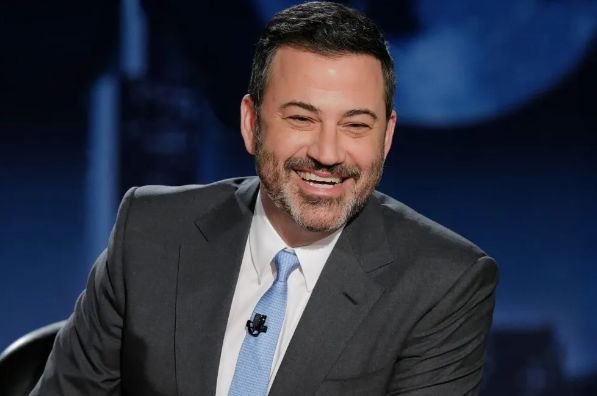Jimmy Kimmel
Jimmy Kimmel is more than just a late-night host — he’s a craftsman of comedy and conversation. From his early days in radio to becoming one of the most influential voices on American television, his career has been shaped by a deep passion for humor, critique, and connection. This profile explores how that calling defined his style, his show, and his personal journey.

Early sparks: humor, broadcasting and a boy who listened differently
Born on November 13, 1967, in Brooklyn and raised in Las Vegas, Jimmy Kimmel didn’t grow up in a typical environment. Las Vegas, the city of neon dreams and unpredictable performances, offered him a front-row seat to the surreal world of entertainment. But Jimmy wasn’t drawn by the lights — he was drawn by the sound.
Long before stepping into the public eye, Kimmel became a student of comedy. He recorded TV shows, mimicked voices, studied radio cadences and dissected punchlines. He was captivated by David Letterman’s irreverence and began to view late-night television as more than just a format — it was a language, one he was determined to speak fluently.
This wasn’t the pursuit of fame. It was a fascination with communication itself — with how humor could connect people across distances. That obsession never left him.
Radio as apprenticeship: timing, voice and discipline
Kimmel’s first real platform wasn’t a screen, but a microphone. His career started in college radio at UNLV’s KUNV, then transitioned to commercial stations like KZZP and KROQ-FM. These early years taught him the economy of words, the rhythm of audience interaction and the art of improvisation.
From 1994 to 1997, as “Jimmy the Sports Guy” on The Kevin and Bean Show, he blended sports commentary with satire in a way that felt fresh, unpredictable and undeniably authentic. Producers started noticing. He wasn’t just funny — he was technically sharp, precise in delivery, and fearless with content.
That blend of spontaneity and structure would later become a foundational trait of his on-screen presence.
Satire with teeth: The Man Show and Crank Yankers
Though he had already gained some exposure co-hosting Win Ben Stein’s Money (which earned him a Daytime Emmy), it was The Man Show (1999–2004) that catapulted Kimmel into mainstream culture. Co-created with Adam Carolla, it was a parody of toxic masculinity long before the term became widely used.
Kimmel walked a tightrope: the show’s tone was crude by design, but its real goal was satirical reflection. Behind every exaggerated skit or absurd premise was a commentary on what men were taught to value.
In Crank Yankers, he took the low-tech premise of prank calls and elevated it with character creation, voice work and puppet animation. It was irreverent, sharp, and often gleefully ridiculous — a testament to his ability to mine humor from the simplest ideas, when executed with precision.
Jimmy Kimmel Live!: building a platform with intention
When ABC tapped him in 2003 to host a late-night talk show, Jimmy Kimmel wasn’t a sure bet. The debut of Jimmy Kimmel Live! was rocky. The set was unconventional. The tone was looser. Ratings were inconsistent. But Kimmel didn’t flinch.
He refused to relinquish creative control, keeping his hands in the writing, production and tone of the show. He knew what he wanted: a space where the unexpected could happen. No rigid formula. No artificial polish.
Over time, the show became a cultural barometer. Segments like “Mean Tweets” went viral not because of gimmicks, but because of timing, honesty and wit. And when moments of seriousness emerged — like his emotional monologue about his son Billy’s heart surgery — Kimmel let the walls drop entirely. He wasn’t playing a role. He was a father on a stage, and the country listened.
Passion in and beyond the spotlight
Kimmel’s intensity doesn’t vanish when the cameras stop. He’s used his platform to speak out on public health, gun control and political hypocrisy — not as a celebrity activist, but as someone who understands the influence of his voice and chooses to use it sparingly but impactfully.
His personal life and professional world often overlap. His wife, Molly McNearney, is a head writer on his show. Their collaboration is not just domestic; it’s creative, fluid, and rooted in mutual respect. Raising a family while producing a nightly show is no easy task, but Kimmel navigates it with grounded clarity, often incorporating real life — joys and challenges alike — into the material he brings to air.
Redefining endurance in the entertainment industry
What makes Kimmel stand out in a saturated media landscape isn’t his fame — it’s his constancy. He’s not flashy, not scandal-prone, not chasing reinvention. Instead, he’s honed his craft. He’s stayed. And that, in a world addicted to the new, is rare.
He doesn’t need to shout to be heard. His passion is quiet, consistent, and woven into every line of dialogue, every segment idea, every last-minute rewrite before taping. For over 20 years, Jimmy Kimmel Live! has been more than a talk show — it’s been a workshop, a journal, a pulpit and a stage.
In the end, the story of Jimmy Kimmel is not about a celebrity. It’s about someone who knew what he loved, never let go of it, and built an enduring platform around it — one punchline, one pause, one truth at a time.
